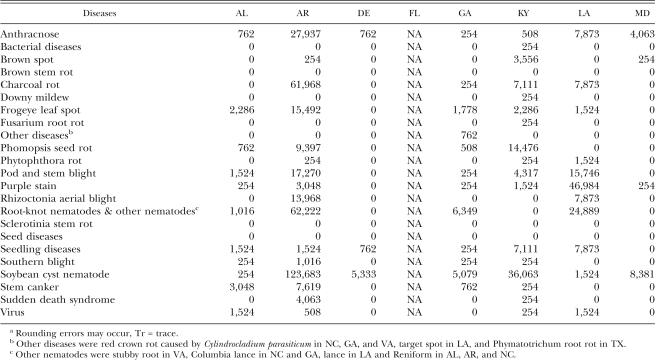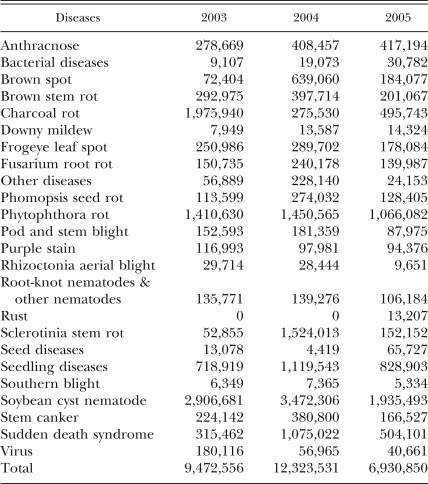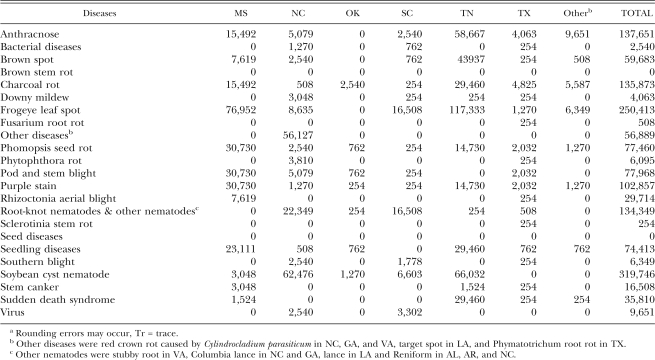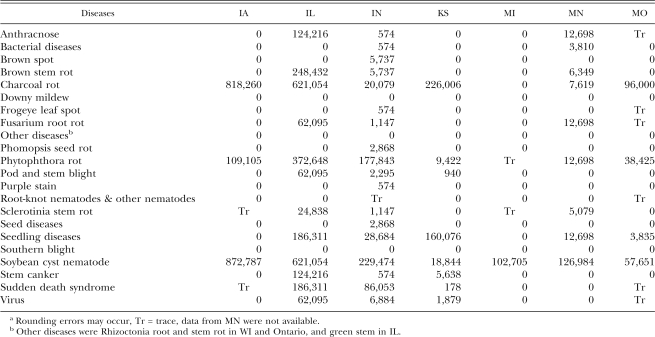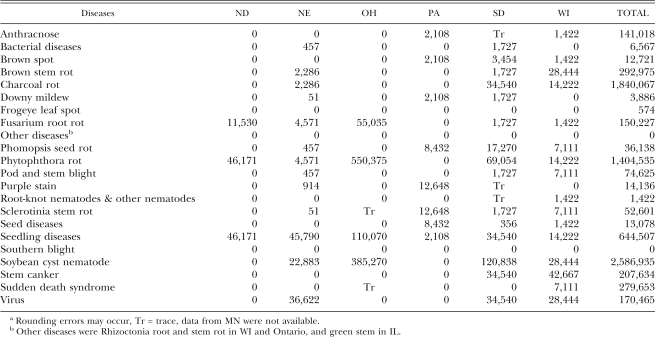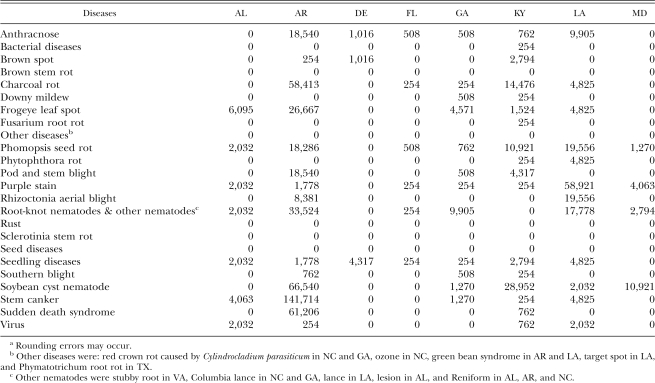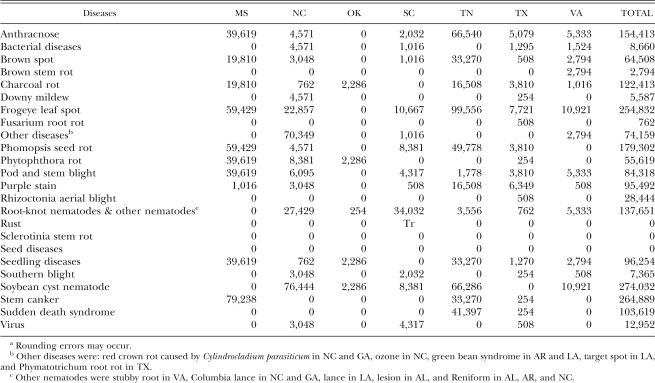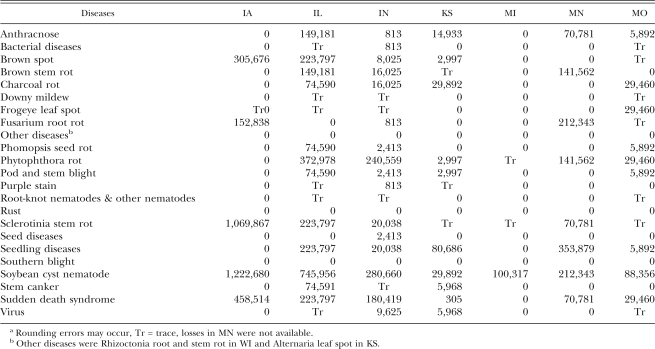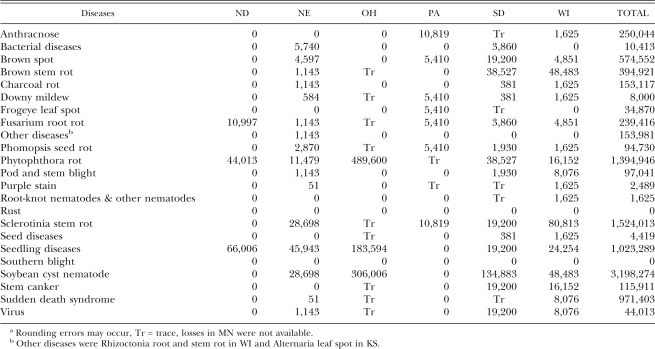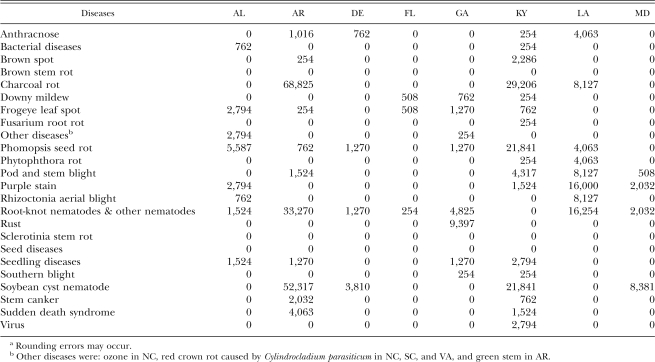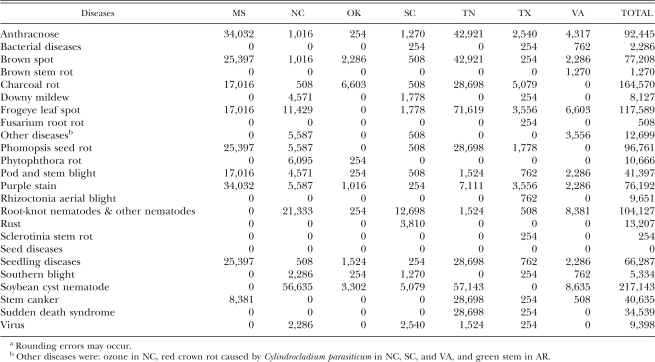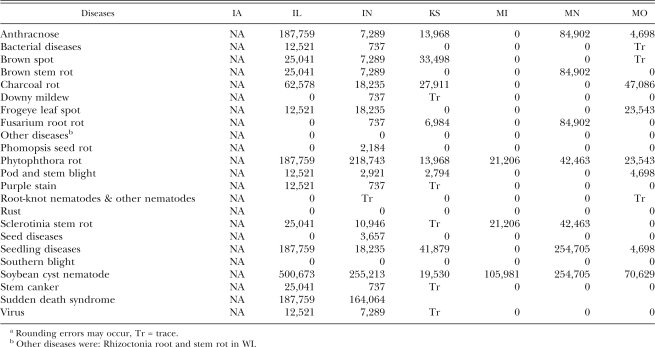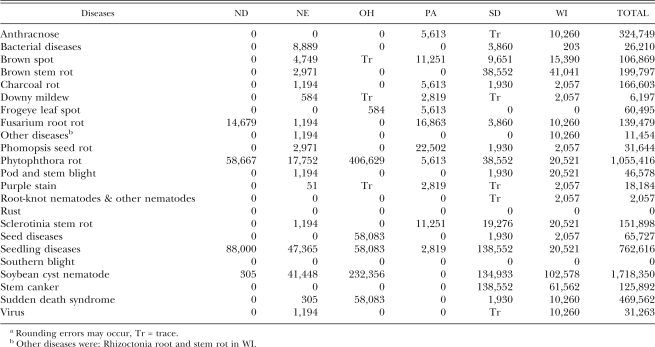Abstract
Research must focus on management of diseases that cause extensive losses, especially when funds for research are limited. Knowledge of the losses caused by various soybean diseases is essential when prioritizing research budgets. The objective of this project was to compile estimates of soybean yields suppressed due to diseases for each soybean-producing state in the US from 2003 to 2005. The goal was to provide this information to help funding agencies and scientists prioritize research objectives and budgets. Yield suppression due to individual diseases varied among regions in the US, and the total of soybean yields suppressed due to diseases in the US varied among years. Soybean cyst nematode suppressed US soybean yield more during 2003 to 2005 than any other disease. Phytophthora root and stem rot, sudden death syndrome, and seedling diseases ranked in the top four on the list of diseases that suppressed soybean yield during these years. This is the first report of soybean yield suppression due to Asian soybean rust in the United States.
Keywords: detection, Heterodera glycines, Glycine max, Phytophthora root and stem rot, rust, soybean, soybean cyst nematode, yield suppression
High yields are critical to US soybean producer profit margins, especially during periods of low prices for soybean. Unfortunately, soybean yields in the US have been suppressed by diseases in the past (Wrather et al., 2001a), and income derived from this crop has been less than optimal. This financial loss is important to rural economies and to the economies of allied industries in urban areas.
Research must focus on management of diseases that cause extensive losses, especially when funds for research are limited. Clearly, knowledge of the losses caused by various soybean diseases is essential when prioritizing research budgets.
The Southern Soybean Disease Workers (SSDW) began reporting estimated soybean losses due to diseases in the southern US in 1974, and a summary of these data from 1974 to 1994 has been published (Wrather et al., 1995). Estimates of soybean yield suppression due to diseases for the US from 1996 to 1998 (Wrather et al., 2001b) and 1999 to 2002 (Wrather et al., 2003) have been published.
The objective of this project was to compile estimates of soybean yields suppressed due to diseases for each soybean-producing state in the US from 2003 to 2005. The goal was to provide this information to help funding agencies and scientists prioritize research objectives and budgets.
This report was prepared through a joint effort of North Central Regional Committee on soybean pathology (NCR-137) and the Southern Soybean Disease Workers. A common objective of these two groups has been to monitor and publicize the development of new or recurring diseases of soybean in North America.
Methods and Materials
Scientists from each soybean-producing state in the US were asked to estimate the percent yield each soybean disease suppressed in their state from 2003 to 2005. These scientists developed their estimates from field surveys, research plot data, and questionnaires given to field workers and extension staff. Most individuals used several of these methods and consulted with their colleagues to develop a percent loss estimate. Production losses for all areas were based on estimates of yield in the absence of disease (Wrather et al., 2001b).
Results and Discussion
During 2003, 62.3 million tonnes (t) of soybean (2.45 billion bushels [bu]) was produced in the US from 29.4 million ha (72.5 million acres), 68.3 million t (2.69 billion bu) were produced from 29.1 million ha (71.80 million acres) in 2004, and 77.3 million t (3.04 billion bu) were produced from 28.8 million ha (71.3 million acres) in 2005.
Disease suppressed soybean production in the US in 2003 to 2005 (Tables 1–7). Yield suppression due to individual diseases varied among regions in the US, and the total amount of soybean yields suppressed due to diseases in the US varied among years (Table 7).
Table 1 (Part I).
Estimated reduction of soybean yields in tonnes due to diseases for 15 southern states during 2003.a
Table 7.
Estimated reduction of US soybean yields in tonnes due to diseases during 2003, 2004, and 2005.
Table 1a (Part II).
Estimated reduction of soybean yields in tonnes due to diseases for 15 southern states during 2003.a
Table 2 (Part I).
Estimated reduction of soybean yields in tonnes due to diseases for 13 northern states during 2003.a
Table 2a (Part II).
Estimated reduction of soybean yields in tonnes due to diseases for 13 northern states during 2003.a
Table 3 (Part I).
Estimated reduction of soybean yields in tonnes due to diseases for 15 southern states during 2004.a
Table 3a (Part II).
Estimated reduction of soybean yields in tonnes due to diseases for 15 southern states during 2004.a
Table 4 (Part I).
Estimated reduction of soybean yields in tonnes due to diseases for 13 northern states during 2004.a
Table 4a (Part II).
Estimated reduction of soybean yields in tonnes due to diseases for 13 northern states during 2004.a
Table 5 (Part I).
Estimated reduction of soybean yields in tonnes due to diseases for 15 southern states during 2005.a
Table 5a (Part II).
Estimated reduction of soybean yields in tonnes due to diseases for 15 southern states during 2005.a
Table 6 (Part I).
Estimated reduction of soybean yields in tonnes due to diseases for 13 northern states during 2005.a
Table 6a (Part II).
Estimated reduction of soybean yields in tonnes due to diseases for 13 northern states during 2005.a
Soybean cyst nematode (Heterodera glycines Ichinohe) (SCN) suppressed US soybean yield more during 2003 to 2005 than any other disease. Phytophthora root and stem rot (Phytophthora sojae (Kaufman & Gerdemann)), sudden death syndrome (Fusarium solani f. sp. glycines (Roy)), and seedling diseases caused by several pathogens ranked from second to forth on the list of diseases that suppressed soybean yield during 2003 to 2005, but not in this order each year. Soybean yield suppression due to charcoal root rot (Macrophomina phaseolina (Tassi) Goidanich) and Sclerotinia stem rot (Sclerotinia sclerotiorum (Lib.) deBary) varied dramatically among years.
Charcoal root rot was second on the list of diseases that suppressed soybean yield during 2003, but it was not among the top 10 during 2004 or 2005. Sclerotinia stem rot was second on the list of diseases that suppressed soybean yield during 2004, but it was not among the top 10 during 2003 or 2005.
Yield suppression due to SCN seemed to decline slightly in the US, from 2.9 million t in 2003 to 1.9 million t in 2005. However, these estimates of soybean yield suppression due to diseases in the US during 2005 do not include data for Iowa. In 2005, the Iowa soybean crop was damaged by SCN, brown spot, frogeye leaf spot, sudden death syndrome, and Sclerotinia stem rot (white mold), but estimates of yields suppressed due to each disease are not available.
Phytophthora root and stem rot caused yield suppression of soybean in most regions in the US during 2003 to 2005. This disease was not a problem in Iowa during 2005. The estimated yield suppression in the US due to this disease declined from 1.4 million t in 2004 to 1.1 million t in 2005. This decline occurred in all regions of the US and was probably due to changes in weather, but may have been due to changes in the pathogen. The yield suppression due to this disease in the US during 2005 was valued at $251.6 million ($236/t).
Yield suppression due to Sclerotinia stem rot was greater in the US for 2004 than 2003 or 2005. This disease has been a problem only for North Dakota, South Dakota, Wisconsin, Iowa, Illinois, Minnesota, and Indiana. The differences in yield suppression due to the disease in the US during 2003 to 2005 were probably due to changes in weather patterns among years.
Charcoal root rot suppressed soybean yield in the US more during 2003 than 2004 or 2005. The reasons for these differences are not clear. Resistant cultivars were not available for planting, so these differences were probably due to yearly variation in weather patterns.
Sudden death syndrome (SDS) suppressed soybean yield more in Arkansas, Iowa, Illinois, Indiana, Minnesota, and Tennessee during 2003 to 2005 than in any other state. Losses to this disease were especially severe in Illinois and Indiana each year. Scherm and Yang (1999) determined that weather patterns were more conducive for this disease for the central than any other area of the US, and these data confirm their observation. The yield suppression due to SDS in the US during 2005 was valued at $118.9 million ($236/t).
Seedling diseases suppressed soybean yields in both the northern and southern regions of the US during 2003 to 2005. The greatest yield suppression due to seedling diseases in the US occurred in Illinois, Kansas, Minnesota, North Dakota, and Ohio. These maladies caused more problems during 2004 than 2003 or 2005, and the weather was probably an important factor.
Rust (Phakopsora pachyrhizi (Syd & P. Syd.)) was first confirmed on soybean in nine states in the continental US during November and December of 2004: Alabama, Arkansas, Florida, Georgia, Louisiana, Missouri, Mississippi, Tennessee, and South Carolina. Rust did not suppress soybean yields during 2004, but did suppress soybean yield in Georgia and South Carolina during 2005.
Reliable estimates of crop losses to diseases based on precise methodology using crop surveys and crop loss models have been very useful for defining the severity of various diseases (James et al., 1991). It is hoped that estimates of soybean yield losses to diseases based on precise methodology will be available in the future.
Footnotes
This paper was solicited by the Editor-in-Chief of JON and was, in part, supported by the Missouri and North Carolina Agriculture Experiment Stations and by USDA Grant 2004-34113-14489. This work was also supported by the U.S. Soybean Fanner Checkoff through the United Soybean Board. The authors thank Joyce Elrod for her efforts in this project.
This paper was edited by David Bird.
Literature Cited
- James WC, Teng PS, Nutter FW. CRC Handbook of Pest Management. Boca Raton, FL: CRC Press; 1991. Estimated losses of crops from plant pathogens; pp. 15–51. [Google Scholar]
- Scherm H, Yang XB. Risk assessment of sudden death syndrome of soybean in the north-central United States. Agricultural Systems. 1999;59:301–310. [Google Scholar]
- Wrather JA, Anderson TR, Arsyad DM, Tan Y, Ploper LD, Porta-Puglia A, Ram HH, Yorinori JT. Soybean disease loss estimates for the top 10 soybean producing countries in 1998. Canadian Journal of Plant Pathology. 2001a;23:115–121. doi: 10.1094/PDIS.1997.81.1.107. [DOI] [PubMed] [Google Scholar]
- Wrather JA, Chambers AY, Fox JA, Moore WF, Sciumbato GL. Soybean disease loss estimates for the southern United States, 1974 to 1994. Plant Disease. 1995;79:1076–1079. doi: 10.1094/PDIS.1998.82.1.114. [DOI] [PubMed] [Google Scholar]
- Wrather JA, Koenning SR, Anderson TR. Effect of diseases on Soybean yields in the United States and Ontario (1999–2002) Online. Plant Health Progress. 2003 doi: 10.1094/PHP-2003-0325-01 RV. [DOI] [Google Scholar]
- Wrather JA, Stienstra WC, Koenning SR. Soybean disease loss estimates for the United States from 1996 to 1998. Canadian Journal of Plant Pathology. 2001b;23:122–131. [Google Scholar]



